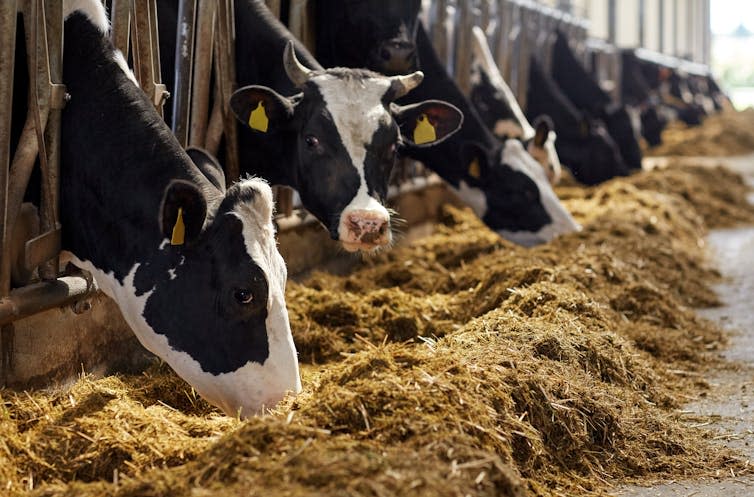A crisis is emerging in the systems that sustain us.
Over a third of humanity’s greenhouse gas emissions come from the way we produce, process and package food. It is also the main driver of the declining diversity of life on earth. To solve these problems, a root and branch reform of farming will be necessary. But so far, the burden has fallen on relatively few shoulders: individual farmers and you, the consumer.
Across Europe, there is growing frustration in rural communities that could discourage efforts to make farming more sustainable, with protests against environmental measures emerging in countries including the France, Germany, the Netherlands and, more recently, Wales.

This round of The Conversation climate coverage comes from our weekly climate action newsletter. Every Wednesday, The Conversation’s environmental editor writes Imagine, a short email that goes a little deeper into one climate issue. Join the 30,000+ readers who have subscribed.
Modern farming methods eat up natural habitat and douse soil, crops and seeds with chemical fertilizers and pesticides. There are types of farming that mix habitats and crops and provide nutrients to the soil in other ways, such as planting more crops that can convert airborne nitrogen into a biologically useful form, such as legumes.
So why aren’t more farmers embracing these changes?
Read more: Why the humble vegetable could be the answer to Europe’s fertilizer addiction
Farming on the edge
“Governments have a duty to achieve net-zero targets while farmers cling to their livelihoods in a difficult economic climate,” says Alex Heffron, PhD candidate in geography at Lancaster University.
“Farmers get very little of the retail value of their produce. Dairy farmers in the UK typically receive less than 1p of the retail value of a 480g block of cheese.”
The profits farmers can expect to make from growing food are being squeezed by rising feed, fuel and fertilizer costs, not to mention interest and energy rates, Heffron says. New regulations and reforms from European governments, designed to encourage greener farming, are considered by many to be the last.
Welsh farmers were once subsidized for their work according to the amount of land they managed. New subsidy schemes in England and Wales aim to pay farmers for public goods instead, such as the amount of habitat they can create or carbon they can store.
The Welsh scheme would require farmers to plant trees on 10% of their land to receive payments. Heffron argues that tenant farmers may not get permission from landowners to do this, and that banks concerned about what tree planting will do to the value of the land may refuse those with mortgages.
Read more: Why are farmers armed? The view from Wales
The scheme may not ultimately benefit food production or the environment, he warns:
“With subsidy levels falling, some UK farmers will have to sell up. Some farms are already being purchased by large investment funds for timber production and the sale of carbon credits to companies seeking to ‘offset’ their emissions, a practice that has been criticized as greening.”
A 2019 analysis by earth systems scientists Simon Lewis (University of Leeds) and Charlotte Wheeler (University of Edinburgh) found that such woody plantations are a pure mimic of naturally regenerating forests, as they store a fraction little carbon in comparison.
Read more: Plantation ‘forest restoration’ scandal is putting climate targets at risk
“The scale of this challenge requires a new kind of politics, rooted not in austerity but renewed public spending on food and farming systems, combined with prompt action against those parts of the supply chain that are hoarding all the profits,” a says Heffron.
Whose job is it?
A handful of companies control the supply chains that collect, process and sell food. Walmart dominates the grocery market in the US and Tesco commands 27% of the UK equivalent.
When such a company announces that it will achieve net zero emissions by a certain date, for example, it is the workers at every link in that supply chain who have to do the heavy lifting. Unfortunately, their employers may lack the necessary resources says Albert Boaitey, lecturer in global agri-food supply chains, Newcastle University.
Read more: Farmers are leading major food companies’ decarbonisation efforts – here’s why
“For example, a cattle farm in Brazil that supplies beef to an overseas multinational retailer would be obligated to emission reduction measures imposed by [the] retailer,” he says. For example, investing in selective breeding programs that produce cattle that consume less feed and avoid fewer greenhouse gases.
Boaitey’s research suggests that farmers are unlikely to make these changes unless beef processors (usually large firms downstream in the supply chain) pay for them. It highlights a report from Barclays bank which found that UK retailers canceled contracts with suppliers worth more than £7 billion in 2021 because they failed to comply with sustainability standards.


“Although our results were published a few years ago, the situation has not changed much,” he says.
You may have noticed that the responsibility of building a sustainable food system falls on you too. With promotional campaigns urging you to consider plant-based alternatives to meat and dairy, the calculation seems to be that one consumer demand can shift away from the most harmful food operations.
But how realistic is this? How much power is there really in the supermarket aisle? Global food system researcher Benjamin Selwyn at the University of Sussex is skeptical, arguing that many of the companies that make vegan burgers and yogurt are also large producers of beef, milk and cheese.
Read more: Meat and dairy industry giants are the plant power behind many vegan brands
The type of food we grow and how we grow it must change fundamentally. Heffron argues that the only way to do this is through a coordinated response that seeks to transform the food system as a whole, and that these complex systems (and many of their -income) best to lead the way. .
While the onus remains on cash-strapped producers and consumers at the other end of the food supply chains, business will continue as usual.


Don’t have the time to read about climate change as much as you’d like?
Get weekly salvation in your inbox instead. Every Wednesday, The Conversation’s environmental editor writes Imagine, a short email that goes a little deeper into one climate issue. Get in touch with the 30,000+ readers who have subscribed so far.
This article from The Conversation is republished under a Creative Commons license. Read the original article.

